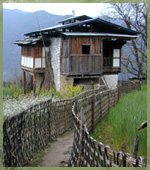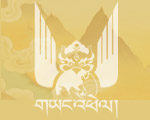|
SUMMARY
- Bhutan is a small Buddhist kingdom in the eastern Himalayas.
- It is Bhutan's difference from other countries and its internal diversity that makes it particularly interesting to foreign visitors.
- Historical circumstance has allowed the kingdom to enter the 21st Century with vibrant traditional Buddhist-inspired cultures and a rich and largely intact natural environment.
- The Royal Government of Bhutan is now attempting to modernize the country whilst preserving its independence and distinct national identity.

TERRITORY
Made up of a collection of high hills and deep valleys, rising from the Indian plains to the Tibetan plateau. Extremely high proportion of land area is unsuitable for agriculture or other productive pursuits. Landscape, though inhospitable for humans, harbors immense ecological wealth and diversity and possesses significant hydropower potential.
- Country name: Bhutan or Drukyul (Thunder Dragon)
- Location: South Asia, eastern Himalayas, between India
and China.
- Geographic coordinates: 27 30 N, 90 30 E
- Area: 46,500 sq/km, similar to Switzerland.
- Dimensions: north-south = 150kms, east-west = 300kms (at
widest points)
- Terrain: mountainous
- Elevation extremes: 100-7750m
- Climate: varies with altitude - sub-tropical, temperate
and alpine, significant localized variation in rainfall
concentrated in monsoon season (mid-June to September)
- Land use: forest = 72%, agriculture = 8%, pasture = 4%,
snow/rock = 16%
- Natural resources: hydropower, timber, assorted mineral
and ecological
HISTORY
Bhutan, as part of the traditional loosely linked Himalayan Diaspora, has historically witnessed a minimal degree of external interaction. The country's history is characterized by its independence and simplicity, essentially tracing the gradual diffusion of Buddhism, political and religious unification, political consolidation under a monarchy, and entry into the modern outside world.
- 8th Century - visit of Guru Rinpoche (the second Buddha) and spread of Buddhism
- 17th Century - political and religious unification under Shabdrung Ngawang Namgyal
- 1907 - Ugyen Wangchuck elected as First King of Bhutan
- 1961 - Bhutan emerges from self-imposed isolation and
begins the process of modernization
LEADING ISSUES
Gross National Happiness
In its approach to modernization Bhutan's leadership is attempting to balance the need for economic growth with other political, social, environmental and spiritual concerns. Gross National Happiness was articulated as a unifying concept to indicate that development has many more dimensions than those associated with Gross National Product. This approach to development is clearly evidenced in government policy.
Southern Problem
In the late 1980s and early 1990s an insurgency occurred in southern Bhutan involving members from the Nepali community. The escalation of events was hugely damaging and led to the polarization of allegiances between so-called "nationals" and "anti-nationals". Bhutan received some unsympathetic and simplistic press coverage over this issue, which failed to place the situation in its necessary contexts. The situation is now diffused, although there remains the difficult matter of refugee camps existing in limbo across the border in Nepal.
|



